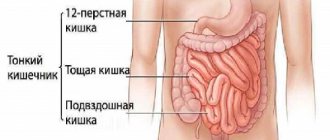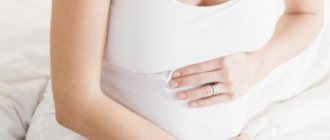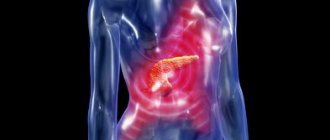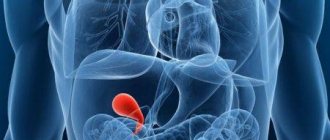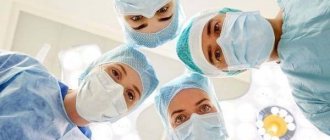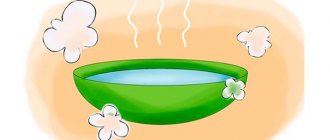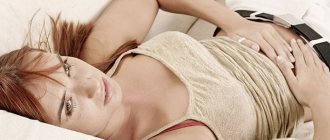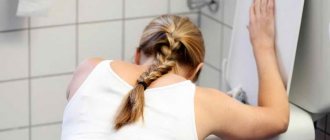861
Acute cholecystitis is a disease in which the walls of the gallbladder are damaged. The pathology has a pronounced course: the concentration of cholesterol in the bile increases, the walls of the bladder atrophy, and the outflow of bile is disrupted. In old age, destructive changes in the organ may occur.
Acute cholecystitis requires complex treatment, which includes taking medications: antibiotics, pain relievers, antispasmodics and choleretic agents.
Cholecystitis: forms of the disease, general information
A pathology that is accompanied by a long-term inflammatory process on the body of the gallbladder is called chronic cholecystitis. Treatment of this disease should begin from the moment the first signs of the disease appear.
Doctors distinguish not only the chronic form of this pathology, but also the acute one. The second poses a great danger to human life, since in the absence of timely medical care during exacerbation of cholecystitis, a sick person may die.
Important! Prevention helps to avoid exacerbation. A person who has previously encountered the problem of gallbladder dysfunction should know how to maintain the functioning of this organ.
Treatment of chronic cholecystitis must necessarily include regular use of medications.
It is sometimes difficult for a person suffering from this disease to force himself to take pills, because in the absence of an exacerbation the disease practically does not manifest itself at all.
Cholecystitis in medicine is considered a dangerous pathology, as it is characterized by impaired bile outflow.
Due to inflammation of the tissue surface of the organ, this liquid slowly enters the stomach. This provokes a sudden feeling of nausea in a person. Nausea is usually preceded by a large meal.
In this case, you need to get rid of cholecystitis so as not to provoke the development of dangerous consequences.
Cholelithiasis
Gradually, stagnation of bile leads to the formation of stones. That is why you cannot simply give up on an inflamed gall bladder (cholecystitis). Treatment of cholelithiasis is more complex and requires special examination and long-term medical support. Moreover, the form of this disease can be different, latent, or dyspeptic, in which attacks of pain are periodic, and they themselves are not too pronounced. The most severe pain is characterized by hepatic colic, which occurs with acute obstruction of the gallbladder and duct. In any case, if the process of stone formation has already begun, this can only be treated with surgical intervention.
Factors provoking cholecystitis
Medical practice proves that most often the provoking factor of cholecystitis is pathogenic microflora.
When a pathogenic infection settles in the intestines, over time it can move throughout the body, “sticking” to the body of another organ; the gallbladder is no exception.
It is difficult to influence such an infection. But a person who follows preventive measures significantly reduces the likelihood of chronic cholecystitis.
Let's consider other factors that provoke the appearance of this unpleasant problem:
- Poor nutrition. To maintain the normal functioning of the body, a person must eat a measured and balanced diet. Abuse of salty and fatty foods always leads to the appearance of pathological processes, for example, inflammation of the gallbladder. It is difficult to predict what form this disease will take if you eat improperly. In any case, cholecystitis provoked by the appearance of errors in the menu is very difficult to treat.
- Abdominal trauma. This factor rarely leads to cholecystitis. However, with a strong blow to the abdominal area, the internal organs may become inflamed. In this case, anti-inflammatory medications will help against cholecystitis.
- Infection of the gastrointestinal tract. The entry of pathogenic microflora into the human body often leads to inflammation. This is one of the side effects of infection.
- Cholelithiasis. Patients of a gastroenterologist who have been diagnosed with this disease are unlikely to complain of poor health in the absence of exacerbation of the disease. The disease is characterized by the formation of calculi within the gallbladder - neoplasms of different sizes and composition. Usually, stones are formed due to a person’s abuse of fatty and fried foods. In this case, the stones are made of cholesterol. Cholelithiasis is dangerous because when moving within the reservoir organ of the stones, the sick person experiences colic - a pain syndrome. This brings him unbearable suffering.
These are not all the reasons for the appearance of this pathology. The chances of developing cholecystitis increase if you are overweight. Now let's look at the symptoms of this disease.
Causes
When wondering whether cholecystitis can be cured completely, one should not forget about the reasons that cause the disease.
It is certainly associated with a hereditary predisposition, although these are, rather, metabolic disorders inherent at the genetic level, which sooner or later lead to failures in the well-functioning system of the human body.
Acute cholecystitis is a consequence of infection or abuse of harmful foods, although it is the latter circumstance that leads to the development of deposition of specific types of stones in the hollow organ.
The formation of stones is associated with metabolic disorders, poor diet and digestion.
The development of acute cholecystitis (one of the most common reasons for contacting an abdominal surgeon) manifests itself against the background of blockage of the bile duct by a stone, an increase in the size of the hollow organ and the development of a purulent process.
The disease is more common in women, which gives reason to associate it with hormonal changes that often occur in the female body.
Therefore, cholecystitis manifests itself during pregnancy (compression of the hollow organ by the enlarged uterus increases) or after the reproductive function begins to decline.
To cure cholecystitis that has developed against the background of metabolic disorders means to eliminate all existing causes of such failures - to regulate the functioning of the pancreas, liver, stomach and intestines, the endocrine system, which produces the necessary hormones for the digestive process.
It's no secret that digestive problems start from poor diet and irregular meals.
Therefore, one of the points in medical recommendations when treating cholecystitis is diet and the correct dietary regimen.
How to cure cholecystitis depends on other causes of its occurrence:
- attached infection (here you need antibiotics of a certain type, and folk remedies, even the most proven ones, are not enough in this case);
- obstruction of the bile duct with a stone (sometimes choleretic agents are useless, because the stone is large and cannot pass out on its own, then timely treatment is only surgical);
- the presence of Giardia, which causes damage to the gallbladder (antiparasitic drugs are needed, although here too much depends on the stage of their presence);
- diabetes mellitus and other endocrine pathologies that require constant treatment;
- viscero-visceral reflexes (irritation of interoreceptors of other internal organs;
- failure of the hepatobiliary system, which includes the biliary system);
- hereditary structural anomalies that cause inflammation of the saccular organ, but cannot be corrected by conservative methods.
In some cases, acute cholecystitis can be cured by performing a surgical operation (by correcting a developmental abnormality, or by removing stones located in a hollow organ).
You can get rid of chronic disease forever by undergoing surgery to remove the gallbladder. Timely prevention of cholecystitis will prevent its occurrence.
But the peculiarities of the development of pathology and its relationship with other gastrointestinal disorders do not give much hope for final and irrevocable success, even the most persistent and high-quality treatment of chronic cholecystitis.
Symptoms of cholecystitis
The main problem of a person faced with this dangerous pathology is pain. With exacerbation of cholecystitis, it occurs regularly.
It is difficult to say how long this pain will last. Usually, if dietary mistakes are made, it may not leave the patient for several hours to days.
But if the patient ate properly, the likelihood that the stones within the gallbladder (in the presence of gallstone pathology, as a predisposing factor for cholecystitis) will move is minimal.
However, cholecystitis causes severe colic, from which most patients lose consciousness. It is a fact.
But pain is far from the only symptom of the inflammatory process on the body of the gallbladder.
Other signs of cholecystitis:
- Aching sensation in the right hypochondrium. They can bother the patient not only during exacerbation, but also during chronic cholecystitis. A person can feel aching discomfort even at night. Dietary errors are not the only factor that provokes their occurrence. Physical overexertion, hypothermia or stress can also remind the patient of the presence of inflammation on his gallbladder.
- Gradual increase in pain. When the lesion of the organ is small, the symptoms of cholecystitis do not appear clearly. But as the focus of inflammation, that is, the lesion, grows, the signs of the disease become more noticeable. Gradually the pain intensifies, causing the patient unbearable suffering.
- Nausea. And the presence of this symptom in cholecystitis indicates a violation of normal bile outflow. After a person has eaten, food passes through the esophagus into the stomach. Bile is needed to digest it. But due to inflammation of the reservoir organ designed to store it, the normal outflow of bile is disrupted. In other words, it does not have time to enter the stomach. A stagnant phenomenon appears. Food stagnates in the stomach and does not enter the intestines due to lack of digestion. Hence its rotting.
- Vomit. With cholecystitis, vomiting occurs only if a person feels sick for a long time. Usually he vomits not only previously eaten food, but also bile.
- The appearance of stones within the reservoir organ. Yes, cholelithiasis can be not only the cause of cholecystitis, but also its consequence. The main factor that provokes the formation of stones in the gallbladder is a violation of the composition of bile. As the pathology develops, the yellow liquid increases its density, which leads to stone formation.
- Increased pain after drinking alcohol.
- Decreased immune function.
Important! With proper nutrition and regular exercise, the risk of cholecystitis is reduced by 2 times.
Which doctor should I contact?
A gastroenterologist treats cholecystitis. In the chronic form of the disease, it will be useful to consult a nutritionist. A physical therapist may provide additional assistance. Video version of the article:
If a person experiences bitterness in the mouth, frequent attacks of nausea, heaviness and dull pain in the right hypochondrium, then the first thought that arises is that there are problems with the liver. On the advice of friends, people start taking hepatoprotective drugs, but the condition does not improve. And all because such symptoms are caused by inflammation of the gallbladder or cholecystitis . In most cases, cholecystitis does not require hospitalization. It is quite possible to treat cholecystitis at home. Today we will talk about what chronic cholecystitis is, symptoms and treatment, diet, folk remedies that are used for this disease.
Chronic cholecystitis can cause symptoms that are similar to other diseases of the internal organs. This fact often misleads doctors when making a diagnosis. The disease is skillfully disguised as:
- pathology of the cardiovascular system (pain in the heart);
- problems with the thyroid gland (constant low-grade fever, tachycardia, mood swings);
- rheumatism;
- CNS disorders (migraine, dizziness, insomnia);
- allergic manifestations and much more.
Pathology develops gradually under the influence of many factors, such as infection, stones, bile stasis, helminths. People who suffer from obesity, hypoacid gastritis, constipation, and dysbacteriosis are at risk. The main symptom of cholecystitis is pain, which is both acute and aching in nature. It depends on what exactly is causing the flare-up. If a person has made a mistake in nutrition or experienced stress, this causes a spasm and, as a result, acute pain. After physical activity, aching pain appears, which can last for quite a long time. There are non-calculous (calculous) and calculous cholecystitis.
Choleretic for cholecystitis
To treat this dangerous pathology, it is necessary to exert a diluting effect on the yellow liquid.
This is required to stimulate its normal outflow. As a result of treatment with choleretic drugs, digestive function can quickly improve.
Let's look at some medications that have a thinning effect on the yellow liquid.
Allohol
The peculiarity of the use of this drug is that it can be used for medicinal purposes not only during exacerbation, but also during chronic cholecystitis.
Advice! Under no circumstances should you self-prescribe choleretic medications. Many of them, including Allochol, have contraindications. Therefore, before purchasing a choleretic medicine, be sure to consult a gastroenterologist.
If there is an exacerbation of cholecystitis, doctors advise taking 3 tablets of Allochol.
The standard duration of such drug therapy is 2 weeks. In some individual cases, doctors extend the choleretic drug course to 8 weeks.
If cholecystitis occurs not in acute, but in chronic form, then we recommend taking 1 to 2 Allochol tablets per day.
Artichol
Almost always, patients whose gallbladder has been inflamed are prescribed Artichol.
Drug treatment of cholecystitis must necessarily be aimed at normalizing the functioning of not only the gallbladder, but also the liver and stomach.
Artikhol copes with this task perfectly. The medication has a mild effect on the above organs, as a result of which, after restoring their functioning, the liver, stomach and gall bladder no longer suffer.
To improve your well-being with cholecystitis, we recommend taking 1 to 2 Artichol tablets three times a day.
The maximum daily dose of this drug is 6. The maximum duration of the treatment course is 3 weeks.
Cyqualon
There is no universal regimen for taking Cicqualon for all patients. The doctor prescribes this medication according to the patients’ individual indications.
Typically, this drug is prescribed only for exacerbation of cholecystitis. To achieve a therapeutic effect, you should use this medicine for cholecystitis 4 times a day, 1 tablet.
Treatment of cholecystitis and pancreatitis
In fact, they very often develop simultaneously, because the provoking factors are in most cases the same. The signs and symptoms, complications, and even the treatment regimen itself are largely the same. Pancreatitis is an inflammation of the pancreas, which is also most often caused by bacteria. With cholecystitis, bile in the bladder stagnates and inflammation begins, and with pancreatitis, instead of entering the intestines, pancreatic juice remains in the gland and digests itself. First of all, the doctor will prescribe you antispasmodics, and only then will deal with the disease. If the pancreas produces too much secretion, then drugs such as Omeprazole are prescribed; if, on the contrary, it is not enough, then Festal, Pancreatin.
Antibiotics for cholecystitis
Cholecystitis is a dangerous pathology, the lack of relief of which will lead to death.
An important component of eliminating the inflammatory focus is the patient's regular use of antibiotics.
These drugs for cholecystitis are recommended for use in 2 cases:
- Cholecystitis became more complicated.
- Cholecystitis arose as a complication of another illness.
Azikar
Doctors advise their patients Azikar if the cause of cholecystitis is the entry of pathogenic bacteria, viruses or infections into the body.
In this case, the patient needs antibacterial drug therapy. In case of gallbladder dysfunction caused by its inflammation, the patient should take 1 capsule of Azicar before sitting down at the table.
Azithromycin
This antibiotic is often prescribed to patients suffering from cholecystitis. Pharmacists offer 2 forms of administration of this drug: tablets and capsules.
It doesn't matter what exactly you buy. Azithromycin should be taken in combination with meals. You should take a tablet of this drug 1 hour before or after a meal.
Both Azithromycin and Azicar should not be taken for more than 3 days. Long-term treatment with antibiotics leads to negative reactions in the body.
To avoid this, upon completion of the drug antibiotic course, the gastroenterologist must adjust the treatment for his patient.
Remember, regardless of the type of antibiotic and the cause of cholecystitis, drinking it for more than 3 days is contraindicated.
Doctors usually prescribe medications from this group to their patients if there is an exacerbation or complication of the inflammatory process.
In other clinical situations, the therapeutic method should be different. That is, if cholecystitis occurs in a chronic form, then it is not advisable to prescribe antibiotics to the patient.
Important point! If the doctor prescribed you a 3-day course of antibiotics due to an exacerbation of cholecystitis, then you will have to completely stop eating until the end of treatment. However, the body should not be allowed to become dehydrated. During 3 days of taking antibiotics, drink plenty of water, tea, juices, compotes and other drinks.
If bile stasis predominates (hypokinesis)
That is, there is insufficiently intense contraction of the gallbladder. In this case, the pain is usually unexpressed, dull, and constant. In this case, tubage also helps well. Among the medications, holokinetics are often prescribed: these are Flamin and Berberine, Sorbitol, Magnesium sulfate. In addition, choleretic herbs help very well in this case. This could be immortelle and corn silk, St. John's wort. They can be brewed and drunk for a long time, like regular tea. In the autumn and spring, they include radiola rosea and lemongrass, eleutherococcus, ginseng, which can increase the tone of the gallbladder and vitality in general.
Painkillers for cholecystitis
Hepatic colic is the main problem of a person facing severe inflammation of the gallbladder.
To solve it, you will need to take the appropriate medicine. In this case, the patient will be helped by antispasmodics.
These drugs can not only stimulate the flow of bile, but also relieve severe subcostal discomfort.
Usually the analgesic effect occurs 10-15 minutes after taking the medicine. However, with exacerbation of cholecystitis, the pain often does not leave the patient for hours.
Intravenous administration of an antispasmodic will help relieve it. Let's talk about popular and effective drugs for eliminating subcostal pain.
Mexican
This is one of the analogues of Baralgin. Mexigan is produced in tablet form. You should drink it after meals.
If the discomfort is mild and nagging, we recommend taking 1 tablet of this remedy.
For severe pain, the dose can be increased. If colic does not go away for a long time, then know that drinking more than 6 tablets of this drug per day is prohibited.
Otherwise, it will not be possible to avoid the occurrence of adverse reactions in the body - an overdose will occur. Drinking Meksinag for more than 5 days is contraindicated.
Took
This medication acts as an analgesic antispasmodic on the affected area. Taking Bral helps relieve severe colic during exacerbation of cholecystitis.
To eliminate aching subcostal discomfort, you need to drink Bral three times a day, 1-2 tablets.
In addition to being a pain reliever, this remedy has a relaxing effect. A person whose cholecystitis has worsened due to stress should take it.
The pain will go away in 10-20 minutes. Bral, just like Mexican, should not be used for pain relief purposes for more than 5 days.
Inflammation of the gastric mucosa and cholecystitis
Also a frequently encountered duet. Moreover, if gastritis and cholecystitis develop together, treatment can be carried out quite successfully, if pancreatitis also develops along with them, then you are guaranteed a long and difficult path to rehabilitation. All three of these organs are prone to self-destruction, since they contain enzymes that digest food. So, gastritis is an inflammation of the gastric mucosa. Pain and discomfort with it are localized in the central, upper part of the abdomen. To treat gastritis, drugs such as Omeprazole and Pariet are used. Additionally, it is recommended to drink fresh potato juice, motherwort and valerian, licorice, plantain and calendula.
Basic recommendations
The very first thing any specialist prescribes for cholecystitis is following a diet corresponding to table number 5. Fatty, smoked, fried, spicy, carbonated drinks and alcohol are contraindicated. Meals should be regular, in small portions, and equal time intervals must be observed between meals so that bile is released evenly.
Vegetarian soups, light broths, boiled meat, fish and vegetables, cereals and puddings are shown. It is healthy to drink mineral water, tea, compote, jelly, dairy and fermented milk products.
Therapy during breastfeeding
The occurrence of pain in the right hypochondrium in new mothers is quite common. Cholecystitis can occur when metabolic processes are disrupted due to childbirth. If a woman was diagnosed with stones in the gallbladder or ducts before pregnancy, then cholecystitis after childbirth is very likely.
Modern doctors do not see an urgent need to stop lactation when treating cholecystitis in the postpartum period. Firstly, this does not always require the use of antibiotics, since more often cholecystitis in this case manifests itself in a chronic course. But even if antibiotic therapy is urgently needed, doctors today can offer their patients several types of effective drugs that will not affect the baby in any way and will not pass into breast milk.
